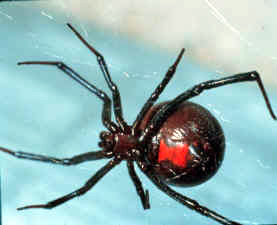Latrodectus mactans
 Black widow spiders are typically shy and retiring. People are occasionally bitten when they accidentally disturb a hidden spider or its web. They can be found in protected cavities outdoors or in structures that are open to the outdoors, especially where insects are common. Around homes, they may live in out-houses, garages, cellars, furniture, shrubbery, ventilators, rain spouts, gas and electric meters and other undisturbed places. They might also be seem in cotton fields and occasionally in vegetable gardens.
Black widow spiders are typically shy and retiring. People are occasionally bitten when they accidentally disturb a hidden spider or its web. They can be found in protected cavities outdoors or in structures that are open to the outdoors, especially where insects are common. Around homes, they may live in out-houses, garages, cellars, furniture, shrubbery, ventilators, rain spouts, gas and electric meters and other undisturbed places. They might also be seem in cotton fields and occasionally in vegetable gardens.
Characteristics
- Typically jet black but coloration may vary depending on species
- Underside of abdomen contains two reddish triangles
- Adults average 1½ inches long
- Have 8 eyes in two rows
- Lay eggs in a loosely woven cup of silk
Bite Symptoms
The bite of a black widow might feel like a pin prick at first, if noticed at all. At the sight of the bite there is usually a slight local swelling and two red spots surrounded by redness. The reaction may become systemic (throughout the body), with pain that becomes intense in 1 to 3 hours and continues for up to 48 hours. Some symptoms include tremors, nausea, vomiting, leg cramps, abdominal pains, profuse perspiration, loss of muscle tone and a rise in blood pressure. Breathing difficulties can also be caused by the toxins. Of the reported black widow bites, less than 5% are fatal.